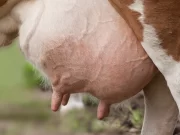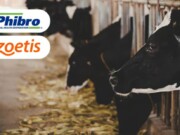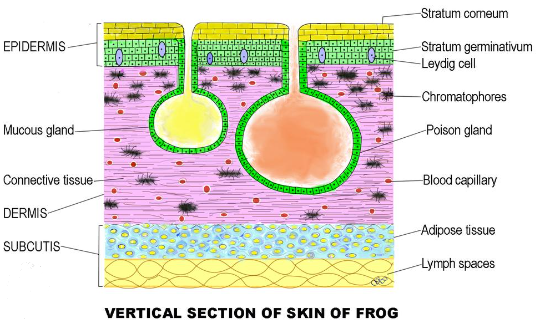
Abstract
Skin, the largest external organ of animal body plays significant physiological and protective roles in the body. The secretory products of skin include sweat and sebum. There are various modes of secretion from the skin glands. The secretory function of skin helps body to excrete the waste products and toxic metabolites, to regulate the body temperature and interaction among the animals through pheromones.
Introduction
Skin is the largest external organ of our body, not only in surface area but even in bulk. The integumentary system consists of two major components; cutaneous membrane called skin and its accessory structures like hair, nails and skin glands. All skin glands consist of a secretory compartment, the gland or coil (tubulus), and an excretory part, the duct (ductus). Skin glands are exocrine kind of glands which release their biochemical products directly onto the skin surface. These skin glands are of epithelial origin, but their secretory compartments are located at different depths in the dermis. Role of integumentary system has multiple roles in homeostasis, including thermoregulation by activating or inhibiting sweat secretion, biochemical synthesis of vitamin D, protects body from injury, have sensory receptors for touch, pressure, temperature and pain. Besides these, skin glands have antibacterial and antifungal actions, excretion of waste products in the form of sweat and body odours.
Structure of the skin
Skin consists of three layers. The epidermis is a vascular and outermost layer, consists keratinocyte cells synthesize keratin, melanocytes cells give protection from UV light, Langerhans cells serve immune function and Merkel cells serve as mechanoreceptors. While the thickness of epidermis varies from 50-150μm depending on the part of the body. Middle layer is the dermis or “true skin” which is thicker than the epidermis and composed of collagen fibres, fibroblast and histiocyte. It is structurally organized into the uppermost papillary and innermost reticular dermis. The sub-papillary plexus provides nutrients to the epidermis. Innermost layer is the hypodermis has loose connective tissue, which connects the skin with internal structures of the body. It serves as insulator to protect body from excessive heat and
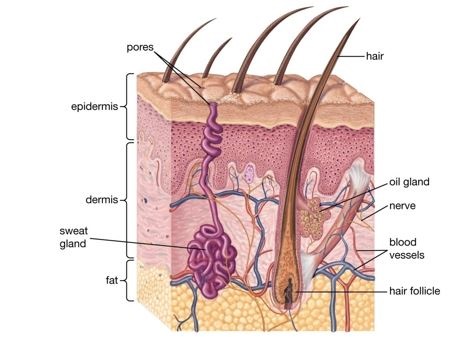
Skin glands and their secretions
- Based on their products: Sebaceous and sweat glands secreting sebum and sweat.
- Based on their secretory function or mode of secretion: Holocrine glands which include sebaceous glands, apocrine sweat glands that release both the cytoplasmic contents and cell membranes into their ducts. Another is merocrine glands i.e.; eccrine sweat glands excrete their products via exocytosis from secretory cells.
- Based on their location of products secreted: The ducts of sebaceous glands is in the innermost, apocrine sweat glands excrete their products into the hair follicle canal, and eccrine sweat glands excrete their products directly onto the skin surface.
Sebaceous gland
Sebaceous glands are located throughout the skin, at the side of the hair follicle and are ovoid or spherical in shape. It is absent in the thick skin present at the sole of feet. Sebaceous glands open into the neck of the hair follicle through a duct except in face, lips, glans penis and labia minora glands it open directly into the exterior. Sebaceous glands are oil (sebum) secreting glands and require eight days for its production. Sebum consists of Glycerides (30-50%), Fatty acids (15-30%), Waxes (26-30%), Squalene (12-20%) and Cholesterol (1.5-2.5%). Increased sex hormones activate sebaceous gland at the time of puberty particularly dehydroepiandrosterone due to which development of acne (localized inflammatory condition) observed. Sebum content of various free fatty acid acts as antibacterial and antifungal actions against skin bacterial and fungal infections.
Sweat glands (sudoriferous glands)
Sweat glands are of two types as eccrine and apocrine glands. Eccrine sweat glands are a tubular coiled gland and the most numerous glands distributed across nearly the entire body surface area. It is responsible for the highest volume of waste products excretion as sweat (clear and watery odourless substance).Sweat consists of mostly water, NaCl, urea and lactic acid. It also plays an important role in body temperature regulation.
Apocrine glands are limited to specific areas of the body like umbilicus. The coiled portion of apocrine glands lies into deep dermis but the duct opens into the hair follicle above the opening of sebaceous gland. Apocrine sweat glands are non-functional till puberty and develop due to the influence of gonadal hormones. Once developed, they start functioning independently. The function of these glands gradually declines with aging. Apocrine glands unlike the eccrine glands, secret thick and milky sweat with much lesser in production. The secretion contains water, protein, carbohydrate waste material and NaCl. It serve virtually no role in body temperature regulation, but largely responsible for body odours as their excretions are converted by skin bacteria into various chemicals. In horse, cattle apocrine glands help in heat loss but limited role in dog, cat, goat and pig.
There is variability in regional and whole-body sweating rate within and between individuals due to differences in sweat secretion rate per gland rather than the total number of active sweat glands.
Skin glands performing various role
- Excretion of waste products:- Skin glands help removal of body waste products by secreting them as sweat and sebum. Sweating eliminates excess water, salts and small amount of urea which are continuously produced in the body.
- Secretion of sexual pheromones:- Pheromones are a group of chemical substances secreted by scent gland of sweat gland. Pheromones cause some behavioural or physiological changes in other members of the same species. Scent glands are not confined to urogenital skin but in other areas as well. Elephants have musth glands behind their eyes, male deer in abdomen region and goat scent glands is modified sebaceous glands located around caudomedial aspect of horn base. Pheromones plays vital role in sexual attraction, mother-young interactions, estrus indication, puberty acceleration, reduces postpartum anestrus, hormonal stimulation and enhance smale mating behaviour. Bulls exhibits a specific behaviour called flehmen reaction whenever exposed to estrus cow discharges which is used to detect estrus cow. The sex attractant volatile compounds excreted in the discharges of the estrus female are capable of enhancing successful mating and sperm quantity in male.
- Thermoregulation of body:- Sweat glands play important role in body temperature regulation. The number of sweat glands is not same in all the species. Buffalo has 394/cm2 sweat glands in their skin which cause more prone to heat stroke. While in cattle the number of sweat glands varies from 600/cm2 in Shorthorn cattle to 1600/cm2 in zebu cattle. It is observed that the greater number of sweat glands in zebu cattle is linked with their ability to regulate their body temperature and more heat tolerant than other breeds of cattle. Sweating rates ranged between 189 ± 84.6 and 522 ± 127.7 g/m2‐h in cattle when body temperature ranged between 39.3±0.53°C and 41.7 ±0.19°C respectively.
Eccrine sweat glands play important role in thermoregulation as compare to apocrine sweat glands. Eccrine sweat glands primarily respond to thermal stimuli; particularly increased body core temperature, skin temperature and associated increases in skin blood flow. An increase in body temperature is sensed by central and skin thermoreceptors and this information is processed by the preoptic area of the hypothalamus to trigger the sudomotor response. Recent studies suggested that thermoreceptors in the abdominal region and muscles were found active in the control of sweating. Thermal sweating is mediated predominately by sympathetic cholinergic stimulation.
Sweat production is stimulated through the release of acetylcholine from non-myelinated class C sympathetic postganglionic fibre’s, which binds to muscarinic (subtype 3) receptors on the sweat gland. Eccrine glands also secrete sweat in response to adrenergic stimulation, but to a much lesser extent than that of cholinergic stimulation. Catecholamines, as well as other neuromodulators, such as vasoactive intestinal peptide, calcitonin gene-related peptide, and nitric oxide, have also been found to play minor roles in the neural stimulation of eccrine gland sweating. In addition, eccrine sweat glands respond to non-thermal stimuli related to exercise and are thought to be mediated by feed-forward mechanisms related to central command, the exercise presser reflex, osmoreceptors, and possibly baroreceptors.
Sweating rate over the whole body is a product of the density of active sweat glands and the secretion rate per gland. Upon stimulation of sweating, the initial response is a rapid increase in sweat gland recruitment, followed by a more gradual increase in sweat secretion per gland. After the Secretion, evaporation of sweat at the surface of the body results into loss of heat.
During winter body try to gain heat maximum and lost heat minimum. Sebaceous glands play major role during cold environment. Lipids of the sebum prevent heat loss from the body by trapping heat and also protect the skin from unnecessary desquamation and injury caused by dryness.
- Milk secretion:- Milk is secreted by mammary glands. Milk provides passive immunity. Mammary glands are the modified apocrine sweat gland and located in udder. Mammary glands consist of secreting part (alveolus) and duct system. Histologically, in the more advanced mammals it is a compound of tubulo-alveolar type that originates from the ectoderm. The Growth of mammary duct system and alveolar system due to influence of estrogen and progesterone hormones respectively.
Conclusion
Skin glands are exocrine glands, consisting of sudoriferous (sweat) glands and sebaceous glands which form part of the integumentary system. Sweat glands as eccrine sweat glands and apocrine sweat glands, and sebaceous glands produce sebum in maintaining body homeostasis, thermoregulations and keeping the body healthy by preventing accumulation of waste products. Mammary glands, scent glands, ceruminous glands are modified sweat glands present in body performing unique functions.
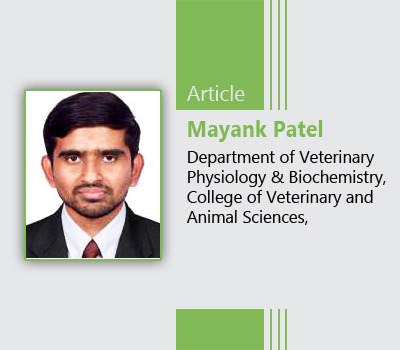
Mayank Patel*, R. Huozha, S. K. Rastogi, Aman Kambojand Mrigakshi Yadav
Department of Veterinary Physiology & Biochemistry,
College of Veterinary and Animal Sciences, G. B. Pant University of Agriculture & Technology, Pantnagar, Uttarakhand
*corresponding author: mayankpatel5015@gmail.com




